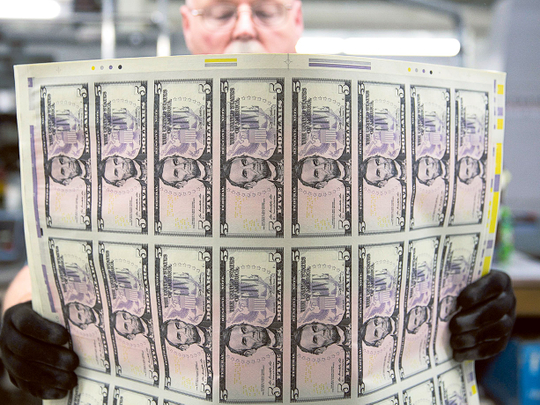
Dubai: The US dollar extended its losses against the yen and euro whole of last week as fresh data indicating a slowdown in the US manufacturing sector lowered expectations the Federal Reserve will hike interest rates any time soon.
“The most powerful currency has been tumbling for three consecutive months. The DXY index which measures the dollar relative to a basket of foreign currencies lost 6.5 per cent in value since beginning of February, mainly due to the shift in the Fed’s tightening outlook from four rate hikes to only two in 2016,” said Hussein Sayed, Chief Market Strategist at FXTM.
US GDP figures last Thursday reinforced Fed’s cautious approach on monetary policy tightening as economic growth dropped sharply with consumers reluctant to spend and businesses reducing their inventories.
The greenback was already under pressure against the yen after the Bank of Japan (BOJ) last week refused to expand its stimulus programme despite a string of weak economic indicators and two deadly earthquakes that closed factories.
Wallowing
The BoJ has left its ultra-expansive monetary policy unchanged, citing that it first wanted to better monitor the effects of negative interest rates introduced in January. Early this week the dollar fell to 106.06 yen at one point before edging up marginally to 106.19 yen. The greenback is wallowing at lows not seen since October 2014. Remarks by Japanese finance minister Taro Aso hinting at a possible market intervention to halt the yen’s rise seemed to have little impact.
With the policy limits of BoJ becoming clearer, analysts see the yen remaining strong against the dollar. “The market is now wondering if the inaction is proof of the claim that the BoJ has reached boundaries to what it can do to stimulate the market,” said Susan Joho, Economist, Julius Baer.
Similar to the BOJ, the European Central Bank (ECB) also has a negative deposit rate and is buying €80 billion (Dh335.8 billion) a month of mainly sovereign bonds. But the delay in expanding bond buying to corporate bonds is keeping the euro stronger.
Strengthening Eurozone data
While nearly all central banks say they don’t target exchange rates, a weaker rate is crucial for the success of the BOJ and ECB’s policies since it helps to import inflation and aids exports by making them relatively cheaper on global markets. But currency analysts in general believe that the BOJ and ECB have little influence on the exchange rates of their respective currencies, which is driven largely by what the US Federal Reserve does next with interest rates.
The strengthening Eurozone data is also unlikely to help dollar’s outlook. The advanced reading of the first quarter US gross domestic product (GDP) reported a quarterly growth rate of 0.5 per cent. The first estimate for Eurozone GDP in the first quarter had been a quarterly growth rate of 0.6 per cent. This number is not annualised and doing so results in a growth rate of 2.4 for the Eurozone.
“This is an impressive advantage, which will reduce interest-rate and monetary-policy divergence between the US and Eurozone. We are revising our 3 month EUR/USD forecast up to 1.15 after an impressive growth advantage of the Eurozone over the US was reported last week,” said David Kohl, Chief Currency Strategist and Head Economist Germany, Julius Baer.
US consumer spending
Last Monday a closely watched gauge of US factories for April showed the rate of growth eased. That came after data last week showed consumer spending rose only slightly in April, while the economy expanded slower than expected in the first three months of the year. The US consumer spending, which accounts for about two-third of the economy increased by 1.9 per cent, the slowest, since Q1 2015.
“Wage gains and weak energy prices were not enough to change US consumers’ behaviour who preferred to reduce their debt and pile some cash into their saving accounts rather than spending it at the shopping malls. The change in consumers’ attitude toward savings and less use of the plastic cards is certainly great from a personal finance perspective, but not the best news for the economy,” said FXTM’s Sayed.
The devil is in the data
The previous week’s US economic announcements did a fair amount of damage to the appeal of the US dollar, owing to their unfortunate implications for the future of US economic growth. The data implies that it is highly unlikely the Fed will hike interest rates at its June policy meeting, while some analysts say September would be the earliest, if at all this year.
The data release on this Friday is also expected to dampen the dollar outlook further. If the nonfarm payroll (NFP) numbers scored more than 200,000 jobs, this indicates that labour markets continue to improve. But analysts say, though unlikely, NFP growth above 200,000 in April will not be a game changer for the US dollar.
“Unless we see a significant improvement in US labour market data, such as 250,000 plus added jobs, average hourly earnings increasing by 0.5 per cent, or unemployment dropping to 4.8 per cent, the dollar isn’t likely to take a U-turn, as investors continue to anticipate that the Fed won’t take action in its next meeting in June,” said Hussein Sayed, Chief Market Strategist at FXTM.










